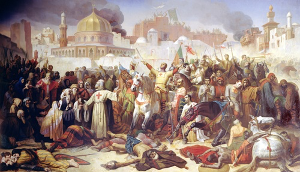The Byzantine Empire
Part 5: The End of an Era Despite the Arab armies' being unable to take Constantinople (thanks to the mysterious superweapon Greek Fire) in the 7th and 8th Centuries, armies from that civilization did take control of much of Asia Minor and the Levant. As well, peoples like the Burgundians and Lombards seized lands in Gaul and northern Italy. The 9th-Century emperor Basil I was successful in retaking much of Italy and some of the Middle East. (It was at this time that Greek became the official language of the Empire.) The second emperor Basil was also successful at reconquest a century later. A sharp defeat at the hands of the Seljuk Turks at Manzikert in 1071 sent the Byzantine civilization into a spiral from which it never really recovered. Not long after that defeat, the emperor Alexios I Komnenos, himself a bit of a reconqueror, appealed to Pope Urban II for assistance in defending Byzantine lands. The pope agreed, in 1095 announcing at a high-level meeting known as the Council of Clermont a call to action that became the First Crusade. The pope promised that anyone who took up arms to fight in the Holy Lands would have their sins forgiven. Many fighters and political leaders joined this effort, pledging (or affirming) their Christian faith. Those who joined, especially those were not Christian before, were said to be "taking the cross." 
The First Crusade was the most successful of all the Crusades, from the viewpoint of the Crusaders. Among the gains were the reconquest of the holy city of Jerusalem and the establishment of the Crusader States: the County of Edessa, the County of Tripoli, and the Principality of Antioch. To help defend these territories, Crusaders encouraged the formation of military orders, including the Knights Hospitaller and the Knights Templar. More Crusaders sailed to the Holy Land, even as more Muslim armies gathered to defend it. Muslim armies captured Edessa in 1144, prompting the Second Crusade. Significant Muslim victories prompted yet another Crusade; this Third one featured the epic struggles of the Muslim leader Saladin and England's Richard I, King of England, which resulted in some short-term gains for the Crusaders but an overall retreat in terms of territory controlled. 
Pope Innocent III called for a new Crusade in 1198. By this time, Western powers and the Byzantine Empire were mired in a political struggle. The Fourth Crusade proceeded as a mission to oust the current Byzantine emperor, Alexius III, and replace him with another ruler, his nephew, who became Alexius IV. The Crusaders ended up declaring war on the fabled city of Constantinople and captured it in 1204, celebrating by engaging in pillage and plunder on a grand scale.  Crusader armies installed their own emperor, and a series of these ruled until 1261, when Byzantine forces, having formed an in-exile government in nearby Nicaea, succeeded in retaking the capital and restoring control. The greatly diminished Roman (Byzantine) Empire soldiered on for another two centuries, battling against a growing Ottoman Empire. It was soldiers representing that power, overseen by Mehmet II, who finally overran the seemingly impregnable walls of Constantinople on May 29, 1453. The ancient capital fell, for the last time, and the Byzantine civilization with it. First page > Royal Precedent > Page 1, 2, 3, 4, 5 |
|
Social Studies for Kids
copyright 2002–2025
David White




